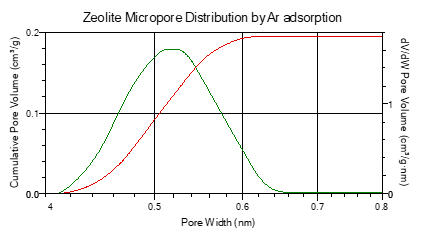




Expertise in the Physical
Characterisation of Materials

MCA Services
Unit 1A Long Barn, North End, Meldreth, Cambridgeshire SG8 6NT UK
01763 262333
© MCA Services




Ultra-micropore Analysis Options
The
term
ultra-micropore
describes
pores
smaller
than
1nm
diameter
(micropores
in
general
are
those
smaller
than
2nm
diameter).
Ultra-
micropores
can
be
present
in
range
of
materials,
such
as:
zeolites,
MOFs,
ZIFs
and
activated
carbons.
When
present,
their
size,
volume
and
area
are
often
fundamental
the
functionality
and
performance
of
many
applications,
for
example:
battery
materials,
catalysts,
adsorbents
and
filter
materials.
In
some
instances
their
presence
is
desired,
whereas
in
others
they
may
impart
an
undesired
reduction
in
performance
and
it
is
often
the case that materials must be selected or developed with specific microporous characteristics.
Nitrogen
adsorption
is
commonly
used
for
micropore
analysis
w
ith
excellent
results:
the
large
range
of
data
reduction
options
in
our
instrument
software
provides
a
great
choice
of
pore
modelling
options
and
comparison
with
historical
data.
Furthermore,
full
isotherms
for
the
characterisation
of
micropores
and
mesopores
can
be
measured
readily
in
a
single
analysis.
However,
when
samples
contain
ultra-micropores
smaller
than
approximately
0.5
nm
nitrogen
adsorption
can
become
problematic
and
alternative
gases
are
recommended,
the
selection
depending
on
the
sample
material.
It
is
often
important
to
also
consider
the
intended
use
of
the
material
and
select
an
appropriate
probe
adsorptive.
For
activated
carbon
samples
CO2
adsorption
is
recommended
and
by
combining
this
with
an
N2
adsorption
isotherm
pores
in
the
full
micropore
range
down
to
approximately
0.3
nm
can
be
characterised
in
a
single
report.
The
addition
of
the
CO2
isotherm
data
can
reveal
porosity
that
cannot
be
predicted
from
N2
data
and
which
may
be
fundamentally
important
to
the
functionality
of
the
sample
material.
Alternatively,
for
polar
samples,
such
as
zeolites,
MOFs,
ZIFs,
etc,
Ar
adsorption
is
recommended
which
can
be
undertaken
at
an
analysis
temperature
of
77K or 87K.
Key Information:
•
CO2 adsorption for activated carbo
ns
•
Combined CO2 & N2 adsorption
•
CO2 adsorption can reveal unknown porosity
•
Ar adsorption for zeolites, MOFs, ZIFs etc
•
Ar adsorption at 77K or 87K analysis temperature
•
CO adsorption available
•
O2 adsorption available
•
Micropore size values and micropore size distribution
•
Micropore volume measurement
•
Micropore area value and distribution
•
Data reduction by DFT (Density Functional Theory)
•
Data reduction by NL-DFT (Non-linear Density Functional Theory)
•
Comprehensive degassing options
Our
Micromeritics
3Flex
instrument
is
extremely
powerful
with
cutting
edge
technology
and
software.
A
wealth
of
information
can
be
gained
from
the
comprehensive
data
reduction
software
and
with
our
decades
of
experience
we
are
always
happy
to
determine
the
best
reporting
options
and
pore
models
for
every
sample.
The
combination
of
expertise
and
instrumentation
ensures
that
you
always
receive
the
most
complete and appropriate data possible.







Expertise in the Physical
Characterisation of Materials
MCA Services
Unit 1A Long Barn, North End,
Meldreth, Cambridgeshire SG8 6NT UK
01763 262333
© MCA Services






01763262333
Ultra-micropore Analysis
The
term
ultra-micropore
describes
pores
smaller
than
1nm
diameter
(micropores
in
general
are
those
smaller
than
2nm
diameter).
Ultra-
micropores
can
be
present
in
range
of
materials,
such
as:
zeolites,
MOFs,
ZIFs
and
activated
carbons.
When
present,
their
size,
volume
and
area
are
often
fundamental
the
functionality
and
performance
of
many
applications,
for
example:
battery
materials,
catalysts,
adsorbents
and
filter
materials.
In
some
instances
their
presence
is
desired,
whereas
in
others
they
may
impart
an
undesired
reduction
in
performance
and
it
is
often
the
case
that
materials
must
be
selected
or
developed
with
specific microporous characteristics.
Nitrogen
adsorption
is
commonly
used
for
micropore
analysis
with
excellent
results:
the
large
range
of
data
reduction
options
in
our
instrument
software
provides
a
great
choice
of
pore
modelling
options
and
comparison
with
historical
data.
Furthermore,
full
isotherms
for
the
characterisation
of
micropores
and
mesopores
can
be
measured
readily
in
a
single
analysis.
However,
when
samples
contain
ultra-
micropores
smaller
than
approximately
0.5
nm
nitrogen
adsorption
can
become
problematic
and
alternative
gases
are
recommended,
the
selection
depending
on
the
sample
material.
It
is
often
important
to
also
consider
the
intended
use
of
the
material
and
select
an
appropriate probe adsorptive.
For
activated
carbon
samples
CO2
adsorption
is
recommended
and
by
combining
this
with
an
N2
adsorption
isotherm
pores
in
the
full
micropore
range
down
to
approximately
0.3
nm
can
be
characterised
in
a
single
report.
The
addition
of
the
CO2
isotherm
data
can
reveal
porosity
that
cannot
be
predicted
from
N2
data
and
which
may
be
fundamentally
important
to
the
functionality
of
the
sample
material.
Alternatively,
for
polar
samples,
such
as
zeolites,
MOFs,
ZIFs,
etc,
Ar
adsorption
is
recommended
which
can
be
undertaken
at
an
analysis temperature of 77K or 87K.
Key Information:
•
CO2 adsorption for activated carbons
•
Combined CO2 & N2 adsorption
•
CO2 adsorption can reveal unknown porosity
•
Ar adsorption for zeolites, MOFs, ZIFs etc
•
Ar adsorption at 77K or 87K analysis temperature
•
CO adsorption available
•
O2 adsorption available
•
Micropore size values and micropore size distribution
•
Micropore volume measurement
•
Micropore area value and distribution
•
Data reduction by DFT (Density Functional Theory)
•
Data reduction by NL-DFT (Non-linear Density Functional Theory)
•
Comprehensive degassing options
Our
Micromeritics
3Flex
instrument
is
extremely
powerful
with
cutting
edge
technology
and
software.
A
wealth
of
information
can
be
gained
from
the
comprehensive
data
reduction
software
and
with
our
decades
of
experience
we
are
always
happy
to
determine
the
best
reporting
options
and
pore
models
for
every
sample.
The
combination
of
expertise
and
instrumentation
ensures
that
you
always
receive
the
most complete and appropriate data possible.























